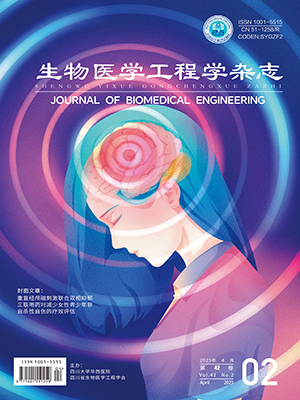| 1. |
Rahib L, Smith B D, Aizenberg R, et al. Projecting cancer incidence and deaths to 2030: the unexpected burden of thyroid, liver, and pancreas cancers in the United States. Cancer Res, 2014, 74(11): 2913-2921.
|
| 2. |
Galanis C, Zamani A, Cameron J L, et al. Resected serous cystic neoplasms of the pancreas: a review of 158 patients with recommendations for treatment. J Gastrointest Surg, 2007, 11(7): 820-826.
|
| 3. |
Jais B, Rebours V, Malleo G, et al. Serous cystic neoplasm of the pancreas: a multinational study of 2622 patients under the auspices of the International Association of Pancreatology and European Pancreatic Club (European Study Group on Cystic Tumors of the Pancreas). Gut, 2015, 65(2): 305-312.
|
| 4. |
Sawhney M S, Al-Bashir S, Cury M S, et al. International consensus guidelines for surgical resection of mucinous neoplasms cannot be applied to all cystic lesions of the pancreas. Clin Gastroenterol Hepatol, 2009, 7(12): 1373-1376.
|
| 5. |
陈梦云, 张翠翠, 轩菡, 等. Ki67 在肿瘤中的表达及其临床指导意义. 现代生物医学进展, 2015, 15(16): 3193-3196.
|
| 6. |
何淑蓉, 崔娣, 宫环, 等. 以 Ki-67 阳性指数行胰腺神经内分泌肿瘤细针穿刺细胞学分级及其与组织学分级的比较. 中华病理学杂志, 2017, 46(6): 393-399.
|
| 7. |
庞旭峰, 王祖森, 吴力群. Ki-67 在肝细胞肝癌患者根治性肝切除术后短期肿瘤复发预测中的价值. 中华肝脏外科手术学电子杂志, 2012, 1(2): 123-128.
|
| 8. |
Sainani N I, Saokar A, Deshpande V, et al. Comparative performance of MDCT and MRI with MR cholangiopancreatography in characterizing small pancreatic cysts. AJR Am J Roentgenol, 2009, 193(3): 722-731.
|
| 9. |
Kickingereder P, Götz M, Muschelli J, et al. Large-scale radiomic profiling of recurrent glioblastoma identifies an imaging predictor for stratifying anti-angiogenic treatment response. Clin Cancer Res, 2016, 22(23): 5765-5771.
|
| 10. |
Guo Yi, Hu Yuzhou, Qiao Mengyun, et al. Radiomics analysis on ultrasound for prediction of biologic behavior in breast invasive ductal carcinoma. Clin Breast Cancer, 2018, 18(3): E335-E344.
|
| 11. |
刘桐桐, 李佳伟, 胡雨舟, 等. 基于影像组学预测乳腺癌雌激素受体表达情况的可行性分析. 生物医学工程学杂志, 2017, 34(4): 597-601.
|
| 12. |
Cameron A, Khalvati F, Haider M A, et al. MAPS: A quantitative radiomics approach for prostate Cancer detection. IEEE Trans Biomed Eng, 2016, 63(6): 1145-1156.
|
| 13. |
胡玉川, 张欣, 崔光彬. 影像组学在肺癌中的应用研究进展. 放射学实践, 2017, 32(12): 1239-1241.
|
| 14. |
Permuth J B, Choi J, Balarunathan Y, et al. Combining radiomic features with a miRNA classifier may improve prediction of malignant pathology for pancreatic intraductal papillary mucinous neoplasms. Oncotarget, 2016, 7(52): 85785-85797.
|
| 15. |
Sahani D V, Kambadakone A, Macari M, et al. Diagnosis and management of cystic pancreatic lesions. Am J Roentgenol, 2013, 200(2): 343-354.
|
| 16. |
Cohen-Scali F, Vilgrain V, Brancatelli G, et al. Discrimination of unilocular macrocystic serous cystadenoma from pancreatic pseudocyst and mucinous cystadenoma with CT: initial observations. Radiology, 2003, 228(3): 727-733.
|
| 17. |
Li Chao, Lin Xiaozhu, Hui Chun, et al. Computer-aided diagnosis for distinguishing pancreatic mucinous cystic neoplasms from serous oligocystic adenomas in spectral CT images. Technol Cancer Res Treat, 2016, 15(1): 44-54.
|
| 18. |
Lv Peijie, Mahyoub R, Lin Xiaozhu, et al. Differentiating pancreatic ductal adenocarcinoma from pancreatic serous cystadenoma, mucinous cystadenoma, and a pseudocyst with detailed analysis of cystic features on CT scans: a preliminary study. Korean J Radiol, 2011, 12(2): 187-195.
|
| 19. |
Zhao Peng, Yu Bin. On model selection consistency of lasso. J Mach Learn Res, 2006, 7(12): 2541-2563.
|




